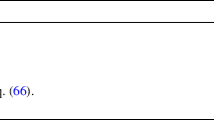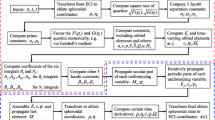Abstract
Two new intermediary orbits of the artificial satellite problem are proposed. The analytical solutions include higher order effects of the geopotential, and are obtained by means of a torsion transformation applied to the quasi-Keplerian system resulting after the elimination of the parallax simplification, for the first intermediary, and after the elimination of the parallax and perigee simplifications, for the second one. The new intermediaries perform notably well for low Earth orbits propagation, are free from special functions, and result advantageous, both in accuracy and efficiency, when compared to the standard Cowell integration of the \(J_2\) problem, thus providing appealing alternatives for onboard, short-term, orbit propagation under limited computational resources.






Similar content being viewed by others
Notes
www.nasa.gov/mission_pages/station/research/experiments/1326.html. Accessed: September 10, 2016.
References
Alfriend, K.T., Coffey, S.L.: Elimination of the perigee in the satellite problem. Celest. Mech. 32(2), 163–172 (1984)
Breakwell, J.V., Vagners, J.: On error bounds and initialization in satellite orbit theories. Celest. Mech. 2(2), 253–264 (1970)
Brouwer, D.: Solution of the problem of artificial satellite theory without drag. Astron. J. 64, 378–397 (1959)
Deprit, A.: The elimination of the parallax in satellite theory. Celest. Mech. 24(2), 111–153 (1981a)
Deprit, A.: The main problem in the theory of artificial satellites to order four. J. Guid. Control Dyn. 4(2), 201–206 (1981b)
Deprit, A., Rom, A.: The main problem of artificial satellite theory for small and moderate eccentricities. Celest. Mech. 2(2), 166–206 (1970)
Garfinkel, B., Aksnes, K.: Spherical coordinate intermediaries for an artificial satellite. Astron. J. 75(1), 85–91 (1970)
Gurfil, P., Lara, M.: Satellite onboard orbit propagation using Deprit’s radial intermediary. Celes. Mech. Dyn. Astron. 120(2), 217–232 (2014)
Hautesserres, D., Lara, M.: A fast and efficient algorithm for onboard LEO intermediary propagation. In: Proceedings of the 6th International Conference on Astrodynamics Tools and Techniques (ICATT), ESA (2016). https://indico.esa.int/indico/event/111/session/12/contribution/16/material/paper/0.png
Hoots, F.R., Roehrich, R.L.: Models for Propagation of the NORAD Element Sets. Project SPACETRACK, Rept. 3, U.S. Air Force Aerospace Defense Command, Colorado Springs (1980)
Kellog, O.D.: Foundations of Potential Theory. Dover, New York (1953)
Knuth, D.: An empirical study of FORTRAN programs. Softw. Pract. Exp. 1(2), 105–133 (1970)
Lara, M.: Efficient formulation of the periodic corrections in Brouwer’s gravity solution. Math. Probl. Eng. 2015, 1–9 (2015a). doi:10.1155/2015/980652
Lara, M.: LEO intermediary propagation as a feasible alternative to Brouwer’s gravity solution. Adv. Space Res. 56(3), 367–376 (2015b)
Lara, M.: On inclination resonances in artificial satellite theory. Acta Astronaut. 110, 239–246 (2015c)
Lara, M., San-Juan, J.F., López-Ochoa, L.M.: Delaunay variables approach to the elimination of the perigee in artificial satellite theory. Celest. Mech. Dyn. Astron. 120(1), 39–56 (2014a)
Lara, M., San-Juan, J.F., López-Ochoa, L.M.: Proper averaging via parallax elimination (AAS 13-722). In: Astrodynamics 2013, vol. 150 of Advances in the Astronautical Sciences, pp. 315–331. American Astronautical Society, Univelt (2014b)
Martinusi, V., Dell’Elce, L., Kerschen, G.: Analytic propagation of near-circular satellite orbits in the atmosphere of an oblate planet. Celest. Mech. Dyn. Astron. 123(1), 85–103 (2015)
Vallado, D.A., Crawford, P., Hujsak, R., Kelso, T.S.: Revisiting spacetrack report #3 (AIAA 2006-6753). In: AIAA/AAS Astrodynamics Specialist Conference and Exhibit. Guidance, Navigation, and Control and Co-located Conferences, pp. 1–88. American Institute of Aeronautics and Astronautics, USA (2006)
Acknowledgments
Part of this research has been supported by the Government of Spain (Projects ESP2013-41634-P and ESP2014-57071-R of the Ministry of Economic Affairs and Competitiveness). This research has made use of NASA’s Astrophysics Data System Bibliographic Services. Preliminary results were presented in KePASSA 2015, Toulouse, France, October 28–30, 2015.
Author information
Authors and Affiliations
Corresponding author
Appendix
Appendix
Calling \(\xi \) to any of the canonical variables and using
as given in Eq. (10), under the simplifications used by the LEO intermediary, the direct transformation is written
and the inverse transformation
The corrections are conveniently expressed in polar nodal variables and are given below, where the eccentricity functions \(\kappa \) and \(\sigma \) defined in Eq. (41) are used for convenience. Besides, the abbreviation \(\tilde{J}_{m}=J_{m}{/}J_{2}^2=\mathcal {O}(1)\), \(m>2\), is used in the second order corrections.
Note that the first order corrections were first provided by Deprit (1981a), and are given here for the sake of completeness—but in the arrangement proposed by Gurfil and Lara (2014) whose evaluation is much more efficient. Besides, second order terms were previously given in Lara (2015b) but limited to the \(J_2\) perturbation.
1.1 First order corrections
The first-order corrections are formally the same both in the direct and inverse transformations but with different signs, namely \({\varDelta }_1={\varDelta }\) and \({\varDelta }_2=-{\varDelta }\) where:
and the right member of each of Eqs. (47)–(52) as well as p in Eq. (44) must be expressed in prime variables when computing \({\varDelta }_1\xi ^{\prime }\equiv {\varDelta }\xi ^{\prime }\), or in original ones when computing \({\varDelta }_2\xi \equiv -{\varDelta }\xi \).
1.2 Second order, simplified inverse corrections
The necessary corrections are given in following formulas, where all the symbols are functions of the original variables. The correction \(\delta _2{R}\) is not used by the accelerated intermediary and is provided just for convenience of those interested in checking Eq. (25).
Rights and permissions
About this article
Cite this article
Hautesserres, D., Lara, M. Intermediary LEO propagation including higher order zonal harmonics. Celest Mech Dyn Astr 127, 505–526 (2017). https://doi.org/10.1007/s10569-016-9736-6
Received:
Revised:
Accepted:
Published:
Issue Date:
DOI: https://doi.org/10.1007/s10569-016-9736-6




